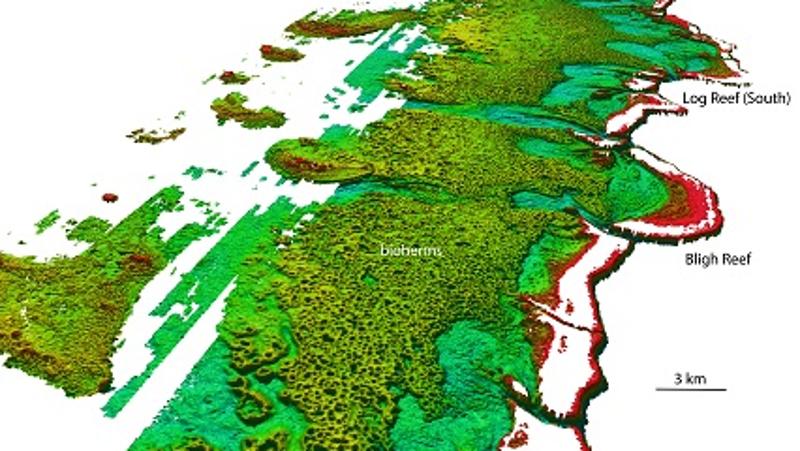
QUT, James Cook University (JCU) and University of Sydney scientists working with laser data from the Royal Australian Navy have revealed a vast reef behind the world-famous Great Barrier Reef.
Mardi McNeil from QUT and lead author on the new research paper published in Coral Reefs (the Journal of the International Society for Reef Studies) about their findings said the extent of the geological structures uncovered was vast.
“We’ve now mapped over 6000 square kilometres. That’s three times the previously estimated size, spanning from the Torres Strait to just north of Port Douglas. They clearly form a significant inter-reef habitat which covers an area greater than the adjacent coral reefs,” said Ms McNeil.
“The sheer size, extent and complexity of the strange donut-shaped circular mounds and hollows completely surprised us. As the data resolution was increased, the more we were amazed.
“This is the first time that the Halimeda bioherms – reef-like structures built of limestone flakes - have been revealed in 3D. We realised immediately previous scientific interpretations of the bioherms needed to be re-assessed.
“What, for example, is the significance of this vast inter-reef habitat in terms of the sheer volume of calcium carbonate; their role in carbon storage; as habitat for biological communities; and in terms of effectively managing the Great Barrier Reef with respect to habitat mapping, boundaries, and conservation zoning.”
JCU’s Dr Robin Beaman said the high-resolution seafloor data provided by LiDAR-equipped aircraft had revealed great fields of the unusual donut-shaped circular mounds, each 200-300 metres across and up to 10 metres deep at the centre.
“We’ve known about these geological structures in the northern Great Barrier Reef since the 1970s and 80s, but never before has the true nature of their shape, size and vast scale been revealed,” Dr Beaman said.
“The deeper seafloor behind the familiar coral reefs amazed us.”
Halimeda bioherms are created by the growth of Halimeda, a common green algae composed of living calcified segments. These form small limestone flakes on death, looking much like white cornflakes. Over time these flakes build up into large reef-like mounds, or bioherms.
Associate Professor Jody Webster from the University of Sydney said the revelations about the extent of the bioherm field make questions over its vulnerability to climate change even more pressing.
“As a calcifying organism, Halimeda may be susceptible to ocean acidification and warming. Have the Halimeda bioherms been impacted, and if so to what extent?”
Dr Beaman said the discovery also opened up many other new avenues of research.
“For instance, what do the 10-20 metre thick sediments of the bioherms tell us about past climate and environmental change on the Great Barrier Reef over this 10,000 year time-scale? And, what is the finer-scale pattern of modern marine life found within and around the bioherms now that we understand their true shape?”
He said future research would require sediment coring, sub-surface geophysical surveys, and employing autonomous underwater vehicle technologies to unravel the physical, chemical and biological processes of the structures.
*Laser Airborne Depth Sounder (LADS) uses red and green LiDAR technology to rapidly scan the seafloor to depths of about 50 metres, generating a dense grid of depth data points. The bathymetry data are then used by the Australian Hydrographic Service (AHS) to revise the nautical charts used by mariners.
* The Weapons Research Establishment first developed LADS airborne LiDAR bathymetry in Australia in 1972. The navy LADS Flight unit is based out of Cairns for year-round surveying of Australia’s shallow waters.
*Less than 15% of the Earth’s oceans deeper than about 200 metres have been mapped using modern surveying techniques.
Media contact:
Amanda Weaver, QUT Media, 07 3138 1841, amanda.weaver@qut.edu.au
After hours: Rose Trapnell, 0407 585 901, media@qut.edu.au


